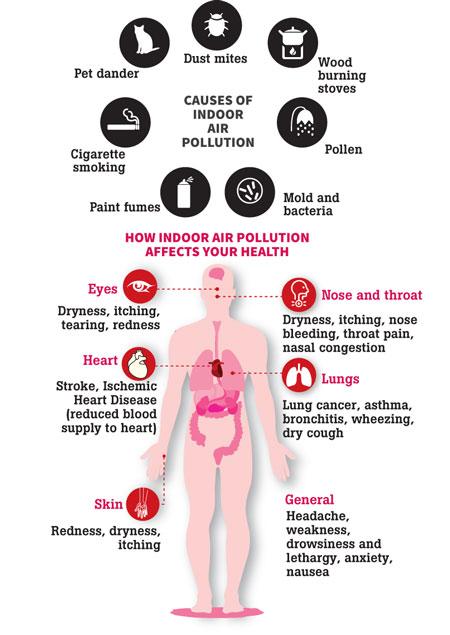05 Apr 2023 - {{hitsCtrl.values.hits}}
Taking a look at the not so talked about issue - indoor air pollution at your home; Experts say household air pollution was responsible for 3.2 million deaths in 2020, including over 237,000 deaths of children, under the age of 5
 Sustaining the cleanliness of the external environment is something we are all concerned about, as it contributes to the prevention of air pollution. Yet, maintaining the purity of the air in the internal or indoor environment is as important, although very little attention is often given to it.
Sustaining the cleanliness of the external environment is something we are all concerned about, as it contributes to the prevention of air pollution. Yet, maintaining the purity of the air in the internal or indoor environment is as important, although very little attention is often given to it.
Indoor air pollution includes dust, dirt, or gases in the air inside buildings which could be at home, work, or school.
The combined effects of ambient air pollution and household air pollution are associated with 6.7 million premature deaths annually. The poor indoor air quality has resulted in lung diseases like asthma, Chronic Obstructive Pulmonary Disease (COPD) and lung cancer. It has also been linked to increased risk of heart disease, strokes and gut diseases.
 In order to make the public and the policymakers aware of this globally growing issue, the Ceylon College of Physicians (CCP) in collaboration with the Sri Lanka College of Pulmonologists held a discussion recently highlighting the magnitude of Indoor Air Pollution (IAP).
In order to make the public and the policymakers aware of this globally growing issue, the Ceylon College of Physicians (CCP) in collaboration with the Sri Lanka College of Pulmonologists held a discussion recently highlighting the magnitude of Indoor Air Pollution (IAP).
“Household air pollution was responsible for 3.2 million deaths in 2020, including over 237,000 deaths of children under the age of 5,” stated Dr Neranjan Dissanayake, Consultant Pulmonologist about the hidden epidemic of indoor air pollution.
Around 2.4 billion people worldwide (around a third of the global population) cook, using open fires or inefficient stoves fuelled by kerosene, biomass (wood, animal dung and crop waste) and coal, which generates harmful household air pollution.
“As firewood is the principal type of cooking fuel in 78.3% of the households in Sri Lanka, the effects of IAP are found here too, mainly because the chemical composition of wood smoke consists of poisonous gases such as Carbon Monoxide (CO),” he said.
“As the CO and PM2.5 (Particulate Matter) concentrations were significantly higher in households using biomass for cooking, the risk of infection-induced asthma among children is also higher,” he noted.
It is also observed that compared to males, females are more vulnerable to bad respiratory health mostly due to cooking fuel.
He also mentioned that the Particulate Matter has the tendency to cause low birth rates which could affect the future generation. As Particulate Matter can change the genetic material for life, the fetus could get affected causing permanent damage to the epigenetic areas.
“Wheezing, exacerbation of asthma, COPD, low birth weight, lung cancer, respiratory infections are some of the health effects caused by certain pollutants such as particulate matter (Small particles <10PM and particularly <2.5PM aerodynamic diameter), Carbon Monoxide Polycyclic aromatic hydrocarbons, Nitrogen Dioxide, and Sulphur Dioxide,” he said.
“In order to lessen the effects or control IAP, using clean cooking substances with proper methods, avoiding a constant/regular usage of mosquito coils and incense sticks and Benzoin Resin (Sambrani) are a few solutions.
“Wearing an N95 face mask in school or workplace is also considered helpful as it would filter the air,”
It is not just about smoke and smoking
Dr Heshani De Silva, Senior Registrar in Respiratory Medicine highlighted the cases of non-smokers involved in paddy cultivation and coconut shell painting, who were exposed to conditions like progressive shortness of breath, Dyspnea due to inhaling dust and other particles in the field.
Dyspnea is the medical term for shortness of breath. People who experience dyspnea feel short of breath. It can range from mild to severe. If this condition is chronic and persistent, it may seriously limit activity and reduce the quality of life. Dyspnea can be a result of lung, heart, vascular, neuromuscular and metabolic disease.
There were other Dyspnea cases reported due to exposure in poultry farm environments and passive smoking.
Dr Leanne Griffin, Consultant Respiratory Physician from Wales, UK discussed and presented an overview of exposure related lung diseases while Dr W. N. S. Kularatne, Consultant Chest Physician, held a discussion on a case study of Hypersensitivity Pneumonitis, which is an overlooked cause of Dyspnea.
Hypersensitivity Pneumonitis is an immune system disorder in which one’s lungs become inflamed as an allergic reaction to inhaled microorganisms, plant and animal proteins or chemicals.
Hypersensitivity pneumonitis is caused when you breathe in a specific substance (allergen) that triggers an allergic reaction in your body. These allergens are often naturally occurring—such as bird feathers or droppings, household mould and animal dander.
However, this is a rare reaction to an allergen that can be present at home, work or outdoors.
10 Jan 2025 44 minute ago
10 Jan 2025 2 hours ago
10 Jan 2025 4 hours ago
10 Jan 2025 4 hours ago
10 Jan 2025 5 hours ago